Sanctuary Socks – free pattern and tutorial
The beginning of the year is a strange time, I always think: on the one hand the new year spreads out before us like a blank canvas, inviting us to fill it with plans and goals, adventures and achievements. On the other, those same plans and goals can so quickly overwhelm us before the year has even properly started. Where to begin? How to fit it all in? How to decide what is truly important as we really can’t do everything?
On top of this, we are encouraged to review last year, to pick out our strengths and weaknesses to see what we can build upon this year. What can we do better, faster, more successfully? It’s no wonder that January can seem like an endlessly long month straight after all the fun of Christmas – and it’s no wonder that the thought of hunkering down is more than a little appealing!
With this in mind, I give you … the Sanctuary Socks. Knitting that takes enough thought to keep those goal-setting worries at bay, but which grows quickly enough thanks to the winding cables that you won’t be knitting them forever. Take some time out to hunker down in your own sanctuary or haven to enjoy some knitting time!
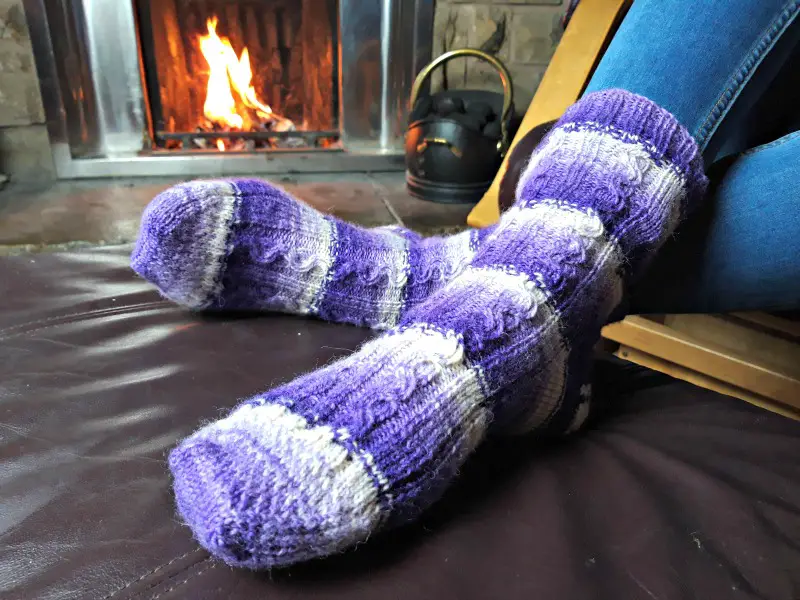
These socks have been designed for the Winwick Mum Winter Haven KAL (knit-a-long) in 2020, although they are an anytime pair of socks, not just for winter. Having said that, the cable stitch which winds its way down the socks is one which I have called the Slalom Cable as the combination of twisted knit stitch and purl reminds me of ski tracks winding down a snowy mountainside. You might even think that they are a metaphor (very apt at this time of year!) for how life twists and turns but keeps on moving – and you could be right!

I’ve knitted the socks in West Yorkshire Spinners Signature 4ply in the Winwick Mum Collection colourway Hidden Gem, and I know that I am totally biased but they have been a joy to knit! Those purple shades have felt like velvet as I’ve knitted further up my socks; odd as the yarn is made from wool and not velvet at all, so I can only put it down to the richness of the colours. Purple is a calming colour – for me, certainly – and I have thoroughly enjoyed watching the amethyst-inspired stripes growing as I’ve worked.

The toe and the heel are worked in Eye of Partridge stitch – something new for my blog patterns – but I fancied a change, and I’m going to be wearing these socks so I need to accommodate for my pokey toes! It’s easy enough to use the Sockalong heel stitch and knit the toes plain if you would rather do that.
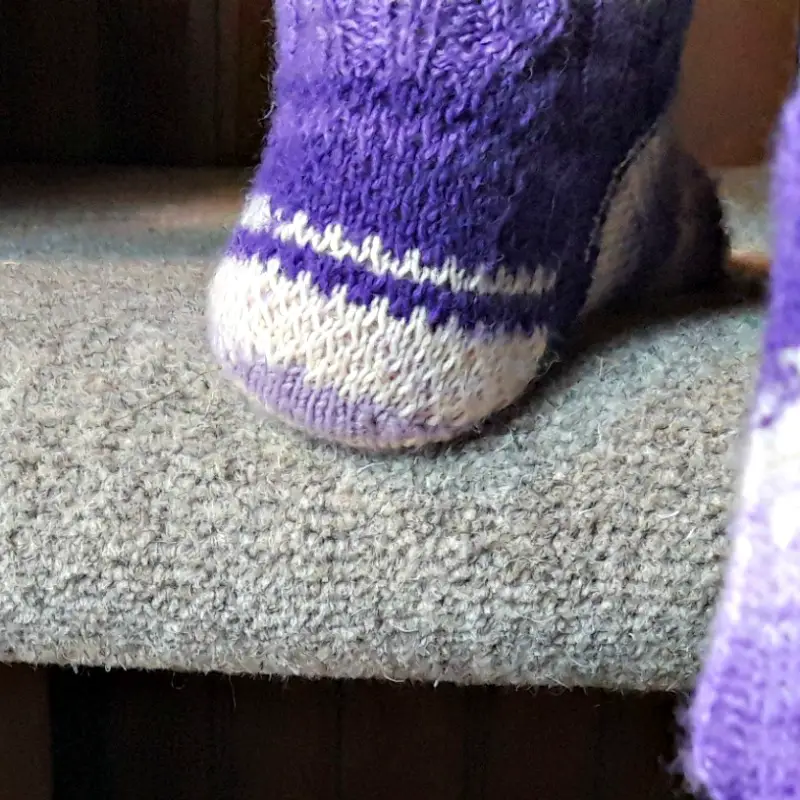
What do you think? Would you like to knit a pair of Sanctuary Socks as your Winter Haven KAL project? A sanctuary is an alternative name for a haven, so I think that these work perfectly!
I’ve written the pattern for you below, and there are some photos to accompany the cable instructions too.
Do note that the sizes have been adjusted accommodate the cables so choose the size that is right for your foot circumference rather than your usual cast on number. Also, if you don’t have a cable needle, it’s fine to improvise with a DPN 😀
Sanctuary Socks
If you’d like a PDF copy of the pattern to work from instead, you can download that here.
These cabled socks are constructed as top down socks with a heel flap and gusset. The cable is a variation of a six-stitch cable which I have called Slalom Cable as the “tracks” created by the twisted knit stitch remind me of ski tracks! The heel is knitted in Eye of Partridge Stitch which creates a durable, cushioned heel and this stitch has been repeated on the toes. This pattern is written for four sizes, and the length of the sock is easily adjusted for any foot.
Size
To fit foot circumference 8 [8.5:9:9.5] inches; 20 [22:23:24] cm
Tension
30 stitches to 4 inches (10 cm) in stocking stitch (worked in the round) on 2.5mm needles
Materials
2.5mm needles – short circular needle, DPNs (double pointed needles) or 80 cm circular for magic loop
1 x 100g ball of West Yorkshire Spinners Signature 4ply in Hidden Gem
1 set DPNs size 3.0mm (optional for a looser cuff)
1 set DPNs size 2.5mm (not required for magic loop)
Cable needle
Stitch holder (optional)
Stitch markers
Wool needle
Abbreviations
K Knit
K2tog Knit two stitches together
SC6L Slalom Cable Left: Slip the next three stitches from the left hand needle onto the cable needle and hold at the front of your work. Knit the next three stitches from the left hand needle then work the 3 stitches on the cable needle as Ktbl, P1, Ktbl.
SC6R Slalom Cable Right: Slip the next three stitches from the left hand needle onto the cable needle and hold at the back of your work. Ktbl, P1, Ktbl from the left hand needle then knit the next three stitches from the cable needle.
P Purl
Sl1 Slip 1 stitch purlwise holding yarn to the back of your work
SSK Slip the first stitch on the left hand needle knitwise onto the right hand needle, slip the second stitch on the left hand needle purlwise onto the right hand needle, slip both stitches back onto the left hand needle and knit together through back loop
St(s) Stitch(es)
( ) Repeat instructions inside brackets
Pattern Notes:
- These socks are knitted on 2.5mm needles, not 3.25mm as stated on the ball band.This will produce a different tension but will ensure a firmer, more hard-wearing fabric for your socks. The ideal tension for these socks is 30 stitches to 10 cm (4 inches) so use whatever size needles are required to reach that tension and do check that your knitted fabric is firm but not stiff.
- It is usual with cable stitches to knit to the next size up to your usual size to accommodate for the fabric pulling in with the cables. The stitch count has already been adjusted to accommodate the cables, so choose the size according to your foot circumference rather than the number of stitches you usually cast on.
- It is often easier to cast on using DPNs before changing to the short circular needle. If you want to use magic loop you will be able to cast on with the larger circular needle if you prefer to do so, but remember not to pull your cast on stitches too tight. If you use DPNs, you might find it easiest to cast on and work 2 rows before dividing the stitches across the needles.
Pattern
Cuff
Using West Yorkshire Spinners Signature 4ply in Hidden Gem, cast on 64 [68:72:76] stitches using 3.0mm double pointed needles.
64 sts(32 sts twice)
Row 1: K1, (P2, K2) 7 times, P2, K1. 32 sts
Row 2: Work knit and purl stitches as they present themselves, turn.
68 sts (34 sts twice)
Row 1: P1, K1, (P2, K2) 7 times, P2, K1, P1. 34 sts
Row 2: Work knit and purl stitches as they present themselves, turn.
72 sts (36 sts twice)
Row 1: P1, (K2, P2) 8 times, K2, P1. 36 sts
Row 2: Work knit and purl stitches as they present themselves, turn.
76sts (38 sts twice)
Row 1: K1, P1, (K2, P2) 8 stitches, K2, P1, K1. 38 sts
Row 2: Work knit and purl stitches as they present themselves, turn.
Change to a 2.5mm short circular needle, magic loop or divide the stitches across DPNs and join into a circle, place marker. You will sew up the small gap where you knitted the first two rows later.
Continue to work row 1 of rib as set for your size for 14 more rounds or until desired length of rib.
Using either written or charted instructions for your size, work each round as given. Rounds 1-12 set pattern and should be repeated for both chart and written instructions. Continue to knit each round until leg measures 6 [7] inches ; 15 [17] cm or desired length from cast on edge, remembering which round of the pattern you finish on for the heel flap.
Before you start the leg section, let me give you a quick tutorial on how to create the Slalom Cable. It’s really not that hard! (Don’t forget that if you’ve never knitted cables before and you’d like to see how the charts and cables work, there’s help on how to do that in my Easy Cable Socks tutorial.)
SC6L – this stands for Slalom Cable 6 (the number of stitches in the cable) Left and you work it like this:
Slip the next three stitches from the left hand needle onto the cable needle and hold it at the front of your work …

Knit the next three stitches from the left hand needle …

then work the 3 stitches on the cable needle as Ktbl …
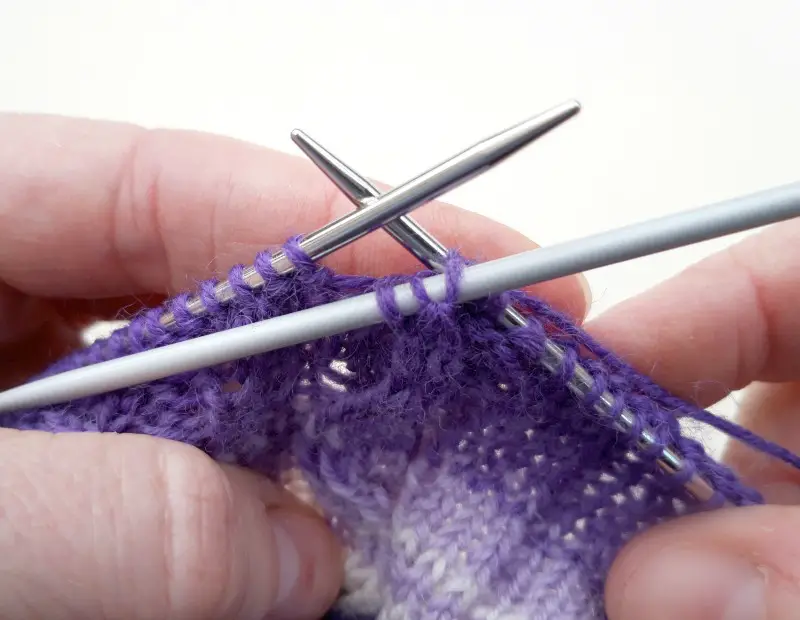
P1 …

Ktbl.
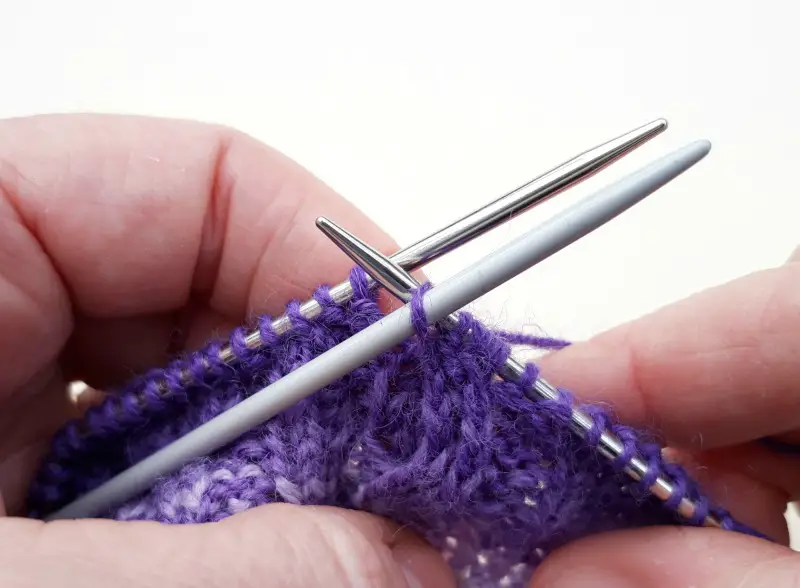
SC6R – this stands for Slalom Cable 6 (the number of stitches in the cable) Right and you work it like this:
Slip the next three stitches from the left hand needle onto the cable needle and hold at the back of your work.
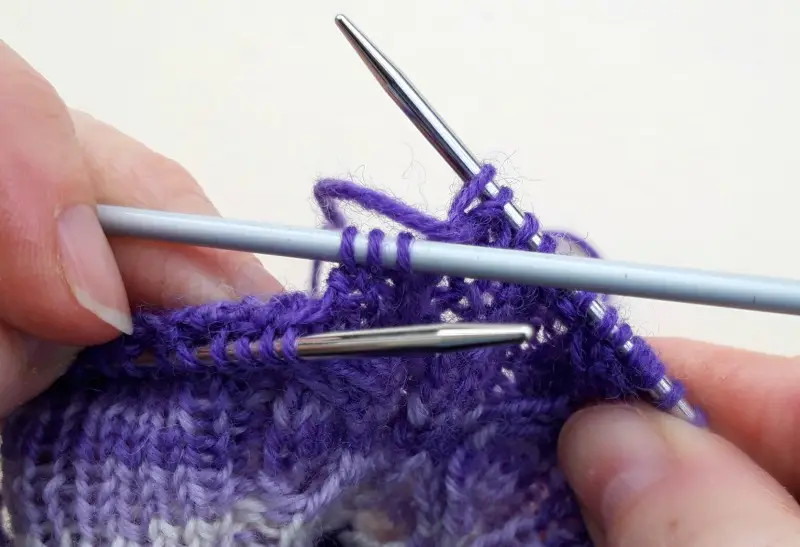
Ktbl …

P1 …

Ktbl from the left hand needle …

then knit the next three stitches from the cable needle.

I hope that was helpful!
Here’s the rest of the pattern:
Written Instructions
64 sts (32 sts twice)
Rounds 1-3: P1, K4, P2, Ktbl, P1, Ktbl, K3, P2, K2, P2, K3, Ktbl, P1, Ktbl, P2, K4, P1. 32 sts
Round 4: P1, K4, P2, SC6L, P2, K2, P2, SC6R, P2, K4, P1.
Rounds 5-9: P1, K4, P2, K3, Ktbl, P1, Ktbl, P2, K2, P2, Ktbl, P1, Ktbl, K3, P2, K4, P1.
Round 10: P1, K4, P2, SC6R, P2, K2, P2, SC6L, P2, K4, P1.
Rounds 11-12: P1, K4, P2, Ktbl, P1, Ktbl, K3, P2, K2, P2, K3, Ktbl, P1, Ktbl, P2, K4, P1.
Rounds 1-12 set pattern and should be repeated.
68 sts (34 sts twice)
Rounds 1-3: K1, P1, K4, P2, Ktbl, P1, Ktbl, K3, P2, K2, P2, K3, Ktbl, P1, Ktbl, P2, K4, P1, K1. 34 sts
Round 4: K1, P1, K4, P2, SC6L, P2, K2, P2, SC6R, P2, K4, P1, K1.
Rounds 5-9: K1, P1, K4, P2, K3, Ktbl, P1, Ktbl, P2, K2, P2, Ktbl, P1, Ktbl, K3, P2, K4, P1, K1.
Round 10: K1, P1, K4, P2, SC6R, P2, K2, P2, SC6L, P2, K4, P1, K1.
Rounds 11-12: K1, P1, K4, P2, Ktbl, P1, Ktbl, K3, P2, K2, P2, K3, Ktbl, P1, Ktbl, P2, K4, P1, K1.
Rounds 1-12 set pattern and should be repeated.
72 sts (36 sts twice)
Rounds 1-3: K1, P2, K4, P2, Ktbl, P1, Ktbl, K3, P2, K2, P2, K3, Ktbl, P1, Ktbl, P2, K4, P2, K1. 36sts
Round 4: K1, P2, K4, P2, SC6L, P2, K2, P2, SC6R, P2, K4, P2, K1
Rounds 5-9: K1, P2, K4, P2, K3, Ktbl, P1, Ktbl, P2, K2, P2, Ktbl, P1, Ktbl, K3, P2, K4, P2, K1.
Round 10: K1, P2, K4, P2, SC6R, P2, K2, P2, SC6L, P2, K4, P2, K1.
Rounds 11-12: K1, P2, K4, P2, Ktbl, P1, Ktbl, K3, P2, K2, P2, K3, Ktbl, P1, Ktbl, P2, K4, P2, K1.
Rounds 1-12 set pattern and should be repeated.
76 sts (38 sts twice)
Rounds 1-3: P1, K2, P1, K4, P2, Ktbl, P1, Ktbl, K3, P2, K2, P2, K3, Ktbl, P1, Ktbl, P2, K4, P1, K2, P1. 38 sts
Round 4: P1, K2, P1, K4, P2, SC6L, P2, K2, P2, SC6R, P2, K4, P1, K2, P1.
Rounds 5-9: P1, K2, P1, K4, P2, K3, Ktbl, P1, Ktbl, P2, K2, P2, Ktbl, P1, Ktbl, K3, P2, K4, P1, K2, P1.
Round 10: P1, K2, P1, K4, P2, SC6R, P2, K2, P2, SC6L, P2, K4, P1, K2, P1.
Rounds 11-12: P1, K2, P1, K4, P2, Ktbl, P1, Ktbl, K3, P2, K2, P2, K3, Ktbl, P1, Ktbl, P2, K4, P1, K2, P1.
Rounds 1-12 set pattern and should be repeated.
Heel Flap
Change to 2.5mm DPNs if you are using a short circular needle. There is no need to use DPNs if you are using magic loop. You may prefer to place the spare stitches from the top of the foot onto a stitch holder if you are using a short circular or DPNs whilst you work the heel.
Row 1: K2, (Sl 1, K1) until you have 32 [34:36:38] sts on your needle, turn.
Row 2: Sl1, P to end, turn.
Row 3: Sl1, (Sl1, K1) to last st, K1, turn.
Row 4: Sl1, P to end, turn.
Row 5: (Sl1, K1) to end, turn.
Repeat rows 2 to 5 until heel flap measures 2 [2:2.5:3] inches; 5 [5:6.5:7.5] cm, finishing on row 3 or 5. If you want to make the heel flap longer, continuing knitting rows 2 to 5 until you reach the desired length, but remember that you will need to pick up more stitches to create the gusset. Now work the heel turn.
Heel turn
Row 1: Sl1, P17 [18:19:20], P2tog, P1, turn.
Row 2: Sl1, K5, SSK, K1, turn.
Row 3: Sl 1, P6, P2tog, P1, turn.
Row 4: Sl 1, K7, SSK, K1, turn.
Continue in this way, adding one stitch between slip stitch and SSK or P2tog on each row (ie, Row 5: Sl1, P8, P2tog, P1; Row 6: Sl1, K9, SSK, K1, etc) until all of the heel stitches are used. Depending on how many stitches are in your heel flap, you may find that the K1 and P1 stitch is not required at the end of the last two rows.
Knit across heel stitches if required to bring you to the left hand side of the heel flap (with the outside of the flap facing you). Pick up and knit 1 stitch for every 2 rows of heel flap knitted. Remember that if you made the heel flap bigger, you will need to pick up more stitches. Once you have picked up the stitches, place marker. Work across the top of the foot stitches in pattern (continuing from where you finished for the heel), place marker, then pick up and knit 1 stitch for every 2 rows of heel flap knitted up the other side of the heel. Knit across the top of the heel and then shape gusset as below.
Note: If you are using DPNs and/or have placed your stitches on a stitch holder, you can arrange the needles as follows: Needle 1 for stitches across heel, Needle 2 for picked-up stitches down side of foot, Needle 3 for stitches across top of foot (knit stitches off stitch holder if required), Needle 4 for picked-up stitches on other side of foot. You may find that stitch markers are not required at first.
Shape gusset
Round 1: K to 3 sts before the marker, K2tog, K1, slip marker, work in pattern to next marker, slip marker, K1, SSK, K to marker.
Round 2: Slip marker, work in pattern to next marker, slip marker, knit to 3 sts before marker.
Round 3: K2tog, K1, slip marker, work in pattern to next marker, slip marker, K1, SSK, K to marker.
Repeat rounds 2 and 3 to shape the gusset. Continue in this way, decreasing by two stitches at the gusset on every other round until there are 64 [68:72:76] stitches on the needle.
Once you have reached the required number of stitches, continue to work each round until you reach 2 inches (5 cm) before the desired length ready to start the toes. Don’t be afraid to try your sock on before decreasing for the toes!
Toes
Note: At some point whilst decreasing for the toes, if you are using a short circular needle you may need to change back to DPNs or use the magic loop method as the number of stitches becomes too small for the circular. It’s up to you when you choose to do that, and how you distribute the stitches across the needles; just keep following the pattern as set below.
Work 4 rounds of Eye of Partridge in the round as follows (using Eye of Partridge creates compressed rounds and therefore a shorter toe so these extra rounds are required – repeat rounds 1-4 if you feel you need to but do be sure to keep the pattern correct across the toes as it may be different from that written. You might feel that it’s easier to work a longer foot section instead!):
Round 1: (Sl1, K1) for 32 [34:36:38] sts, K to end.
Round 2: K one round.
Round 3: (K1, Sl1) for 32 [34:36:38] sts, K to end.
Round 4: K one round.
Toe shaping
Round 1: K1, SSK, (K1, Sl1) to 3 sts before marker, K2tog, K1, slip marker, K1, SSK, knit to 3 sts before marker, K2tog, K1. 60 (64:68:72)sts
Round 2: Knit one round, slipping markers as you come to them.
Repeat rounds 1 and 2 until you have 28 [28:32:32] stitches left and divide these between two needles so that front and back of socks match.
Graft toes using Kitchener stitch, weave in all ends and sew up the small gap at the cuff where you cast on.
Charts
All sizes: Work Slalom Cable SC6L and SC6R as given in abbreviations.
64 sts (32 sts twice)

68 sts (34 sts twice)

72 sts (36 sts twice)

76 sts (38 sts twice)

Don’t forget to link your socks on Ravelry so that others can admire them, and if you would like to share them other social media platforms you can use the hashtags #WinwickMumSocks and #WinterHavenKAL. I’m really looking forward to seeing how your Sanctuary Socks turn out!

This pattern and tutorial is free on this blog and will always remain so, but if you have enjoyed using it and would like to buy me a brew, it will be much appreciated! You can find the donation button on the sidebar on the left hand side. Thank you! xx
This pattern copyright © 2020 Winwick Mum. All rights reserved.
Not to be included in any collection or used for profit without written consent of Winwick Mum.
This pattern is based on my Basic 4ply Socks pattern, which means that you can find photo and video help in the Winwick Mum Sockalong tutorials. You can find out more here:
If you can already knit socks but would like to stay in touch, click the link below to join the Winwick Mum mailing list to hear about the latest blog posts, pattern updates, tutorials and more … but no spam, I promise!


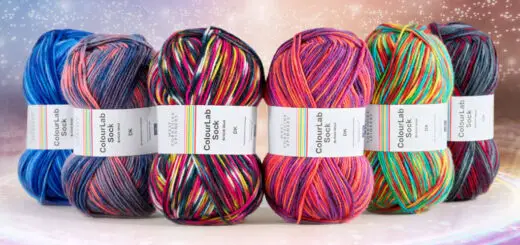

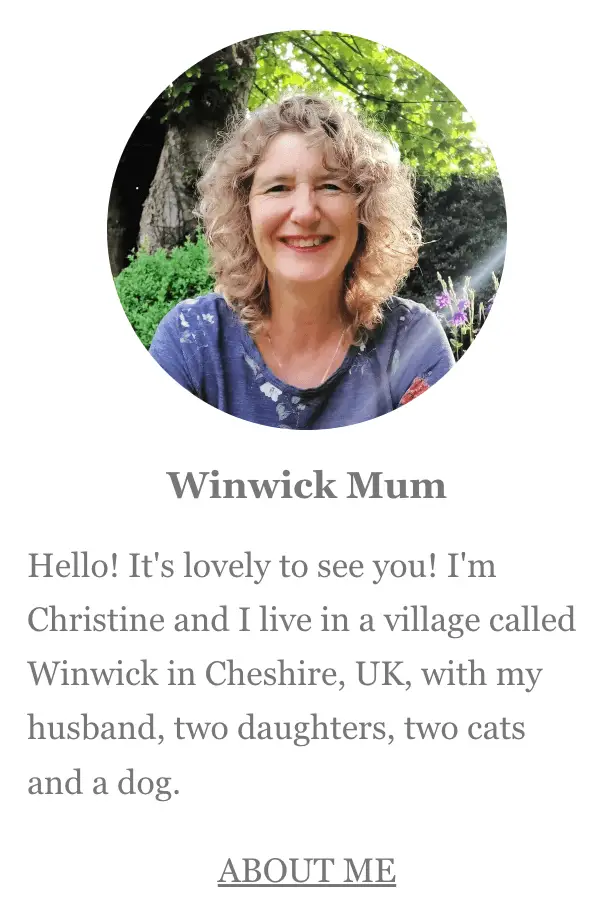

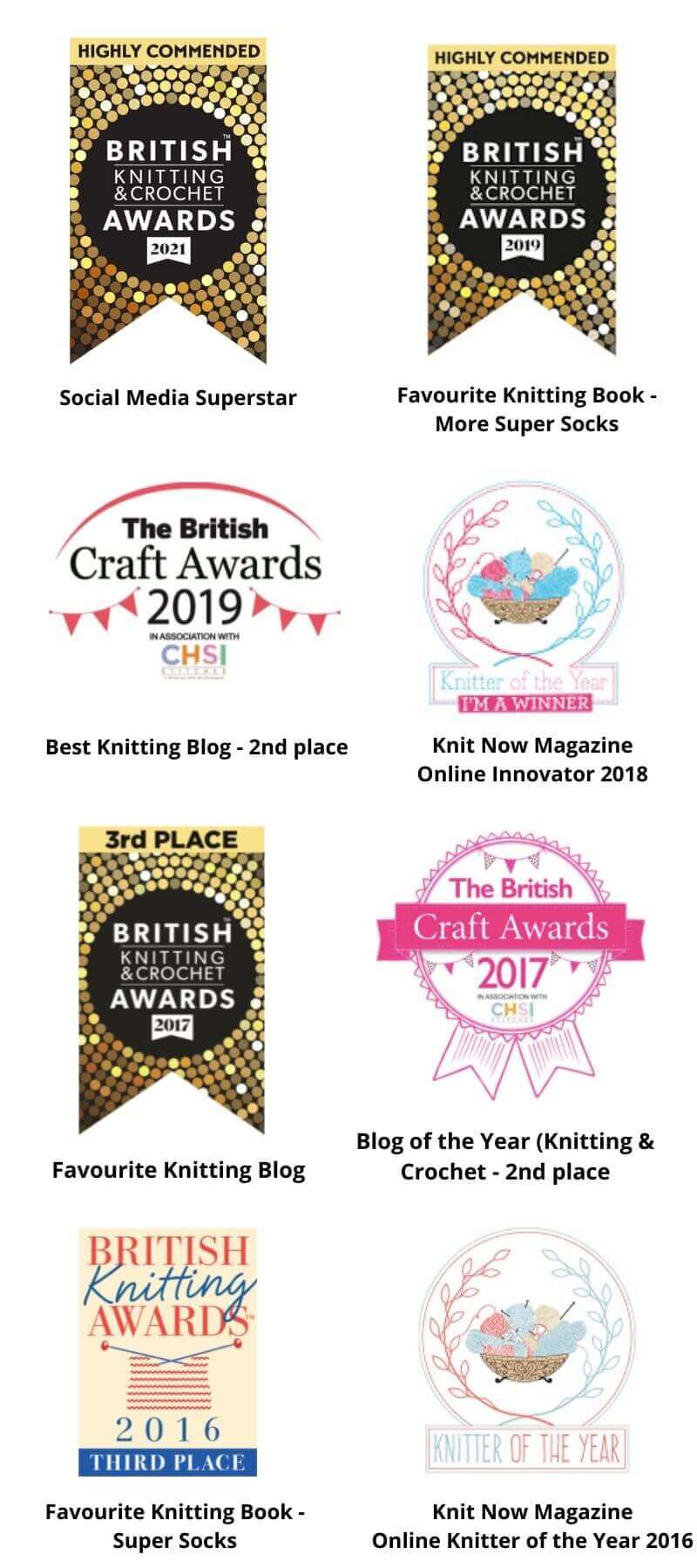

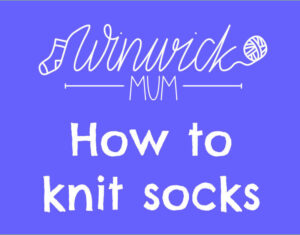


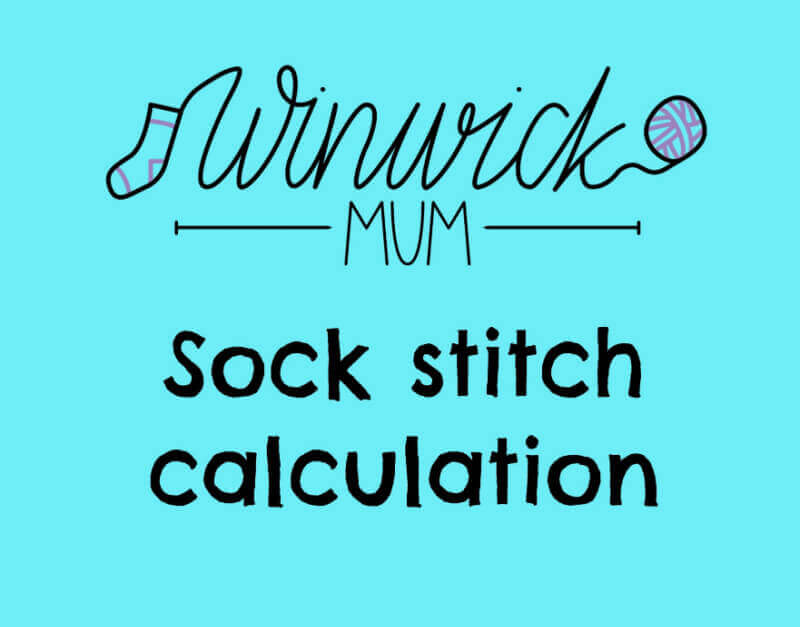
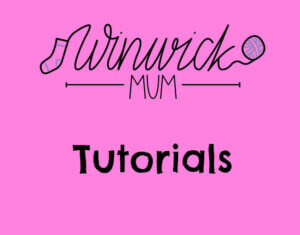




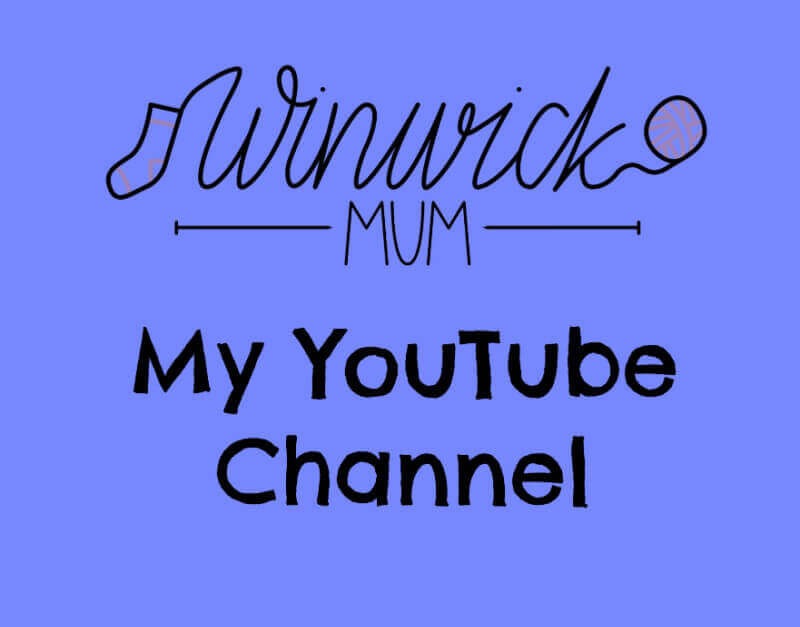
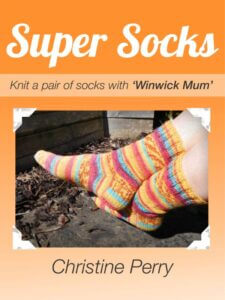
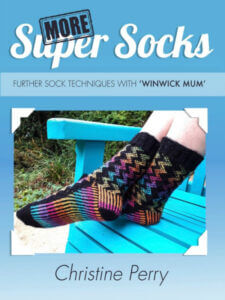


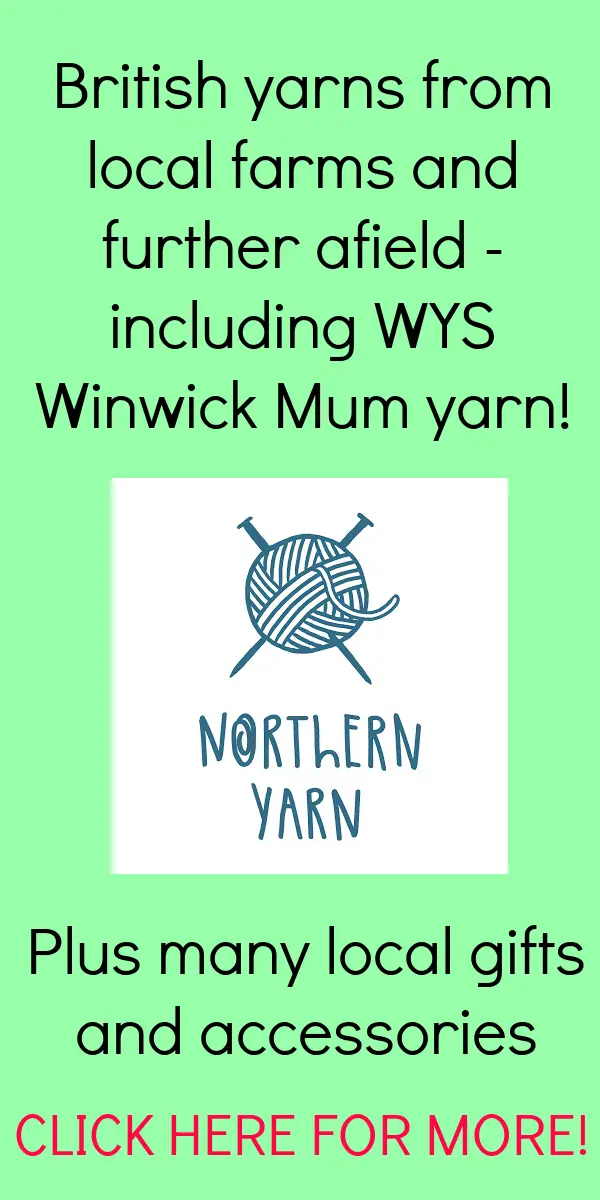

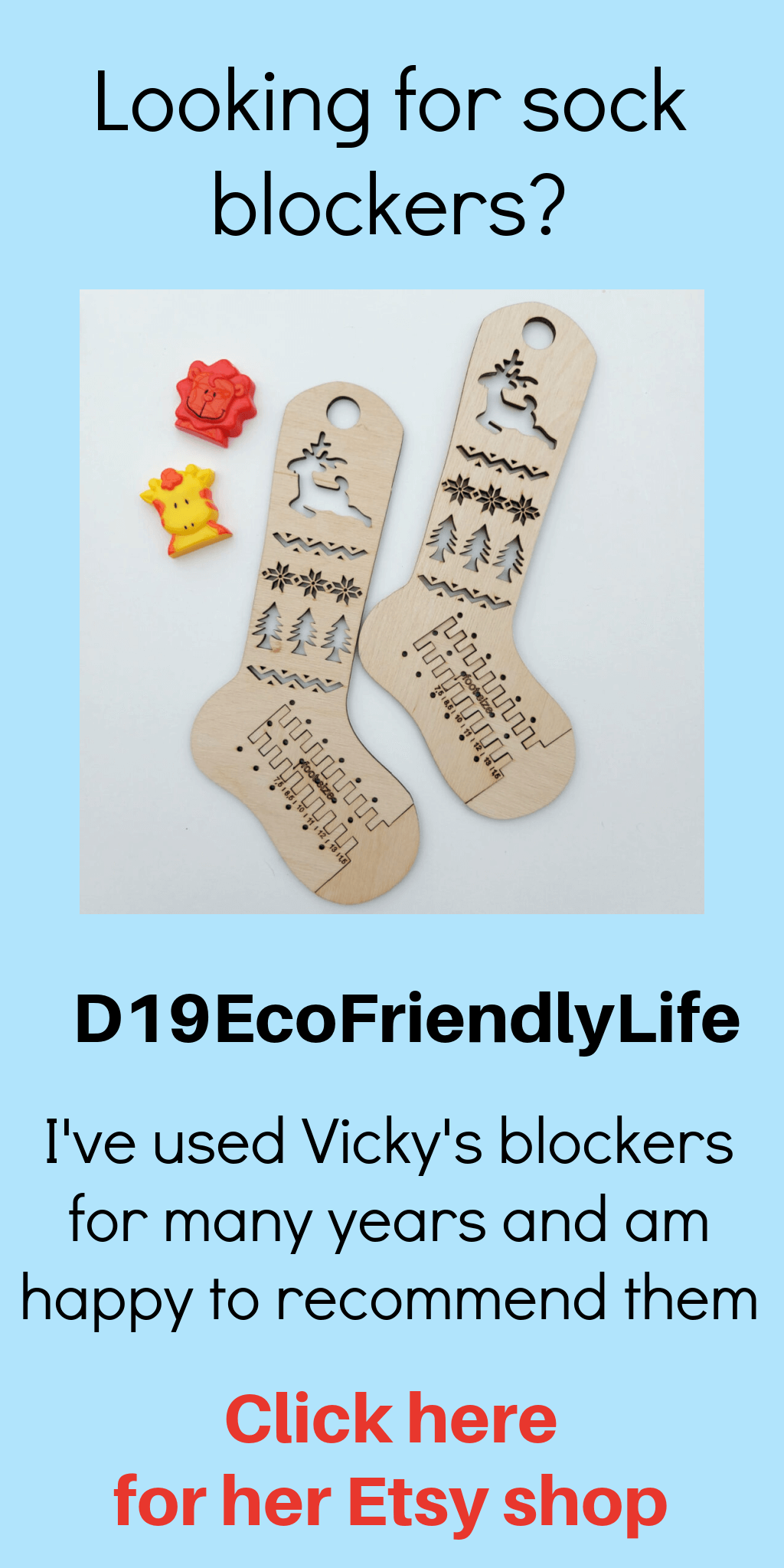

Thank you for this. I've been looking for pattern inspiration for some WYS yarn (Mango Passionfruit Cooler rather than a Winwick Mum shade) and this fits the bill.
Ooh yes, they'd look good in Passionfruit Cooler! xx
Well you certainly made that easy! I have a ball of Hidden Jem and was wondering if your new pattern would work with it. So nice to have the decision of which pattern to use already made:) Your Winter Haven KAL sounds like a very pleasant way to start a new decade. I rarely comment, but would like to let you know that I have enjoyed your blog for quite a few years now. Thank you for all that you share!!
Cory
Ha ha, that did make it very easy for you! Thanks for your comments, it's lovely to know that you've been enjoying the blog! 🙂 xx
How would you work these as short socks? I don't have enough yarn for long cuffs, so planning on just doing my usual 10 rounds of ribbing and then straight into the heel flap.
You could just work the pattern onto the foot – start the pattern on round 1 when you have picked up your gusset stitches and it should work fine 🙂 xx
I love this pattern but would like to make the socks in 6 ply (Trekking). Do you think it will be difficult to adjust from 4 ply to 6 ply? I'm particularly worried about the heel… It seems to be difficult to find an 'interesting' pattern for 6 ply yarn.
There's no reason why you can't try, although you will need to adjust the stitch count for 6ply and see if the pattern still fits into the number of stitches that you have. You're right about patterns for 6ply, there aren't too many of them! xx
I've never done eye of partridge heels, so I'll have to give this one a go! I'm thinking wildflower, or maybe seascape or… Oh dear! Decisions, decisions! xx
Not a bad decision to have make, though 😉 xx
I’m looking forward to starting my socks using this pattern over the weekend. I’ve got a couple of balls of WYS wool but haven’t decided which colour to use yet (or to make them for me or for someone else)!
I’ve not done Eye of Partridge stitch before but the pattern looks very clear as usual for your patterns.
I’m just experimenting with a small pair of socks for my 3 year old grandson for his wellies!
That sounds great! I'm sure your grandson will look very smart in his welly socks, and I hope you enjoy knitting the Sanctuary Socks when you've chosen your yarn! xx
Really looking forward to starting these! Thank you!
You're very welcome 🙂 xx
Hiya, I'm enjoying using this pattern as my first sock from cuff down. I'm confused about how to shape the gusset. Do I turn at the end of each round? or is this one continuous row? I appreciate your patience and enthusiasm!
Hi! No, there's no need to turn, you just keep going in the same direction. The sock shape is based on my basic Sockalong sock so have a look at the Sockalong tutorials (click the big purple picture at the top right of this page) and also my YouTube channel for videos – different patterns but the same process. Hope that helps! xx
Hi, I really want to take part in this so will do, but first I have a jumper to finish one sleeve of and I am also knitting the Isolation hat which was free from Ravelry and was invented by a lady in isolation from Covid. I will hopefully start before everyone else finishes though. And I will be logging in to the KAL because I retrospectively followed the original one ( twice!) and actually managed to get two pairs of lovely socks which I am wearing to Krakow next month ( hopefully assuming I am allowed to go there) so could really do with a third pair to take wth me.
It sounds like you’ve got a plan! You can jump into the KAL whenever you like, and I hope you get your socks finished in time! 🙂 xx
Ah I think the wrong KAL! I will find the correct one for this year!
You can use this pattern if you want to for this year’s KAL, you don’t have to use the new pattern if you’d prefer another. The Week 1 post for this year is here.